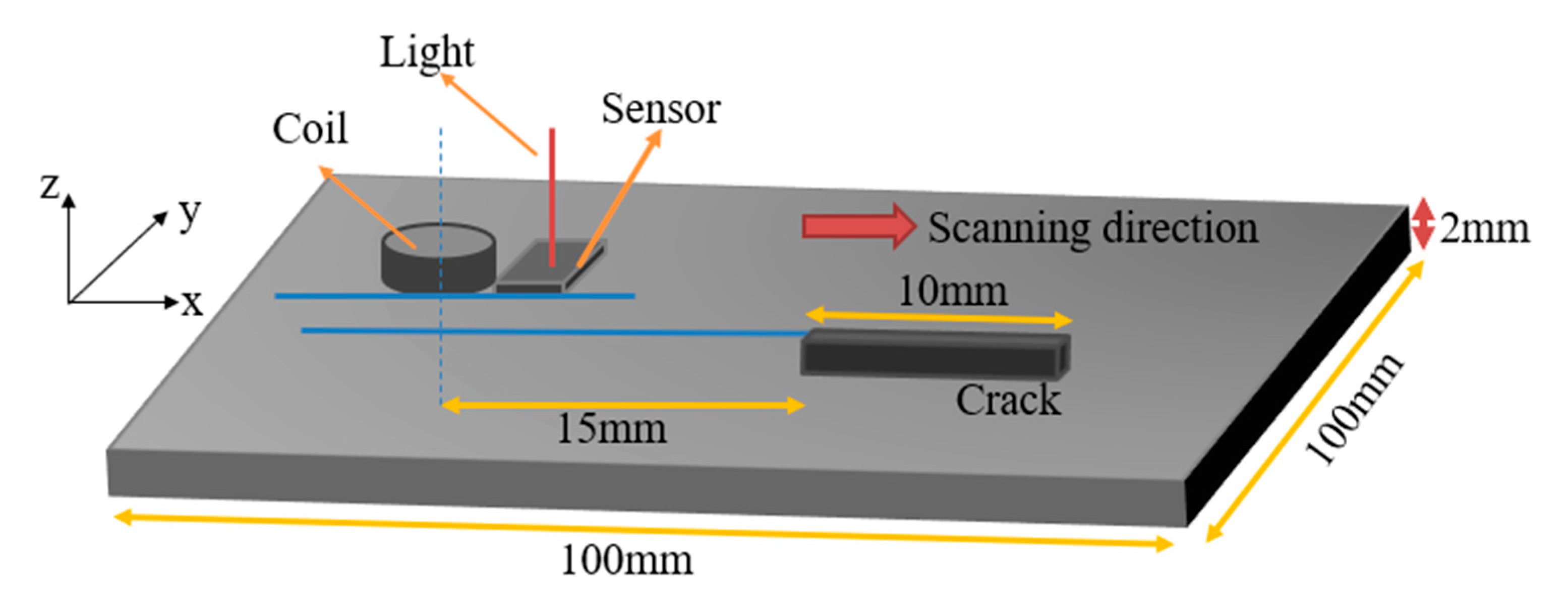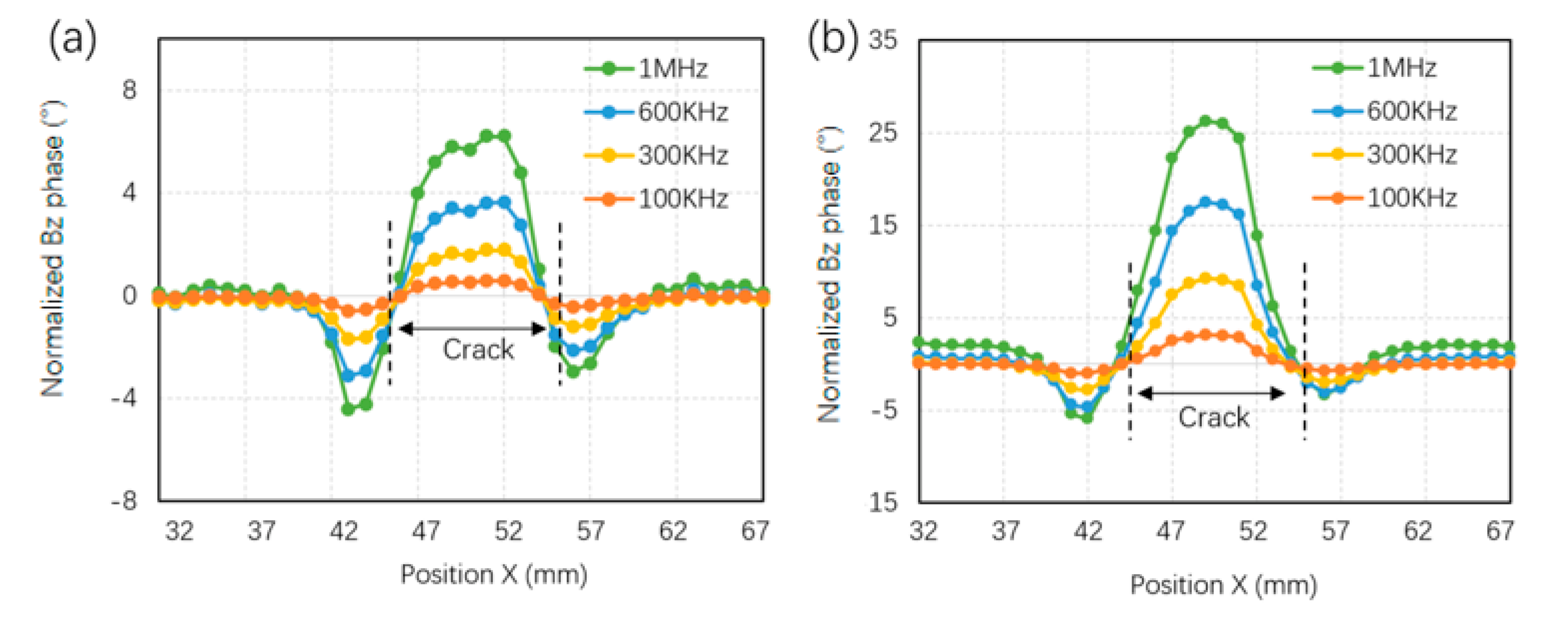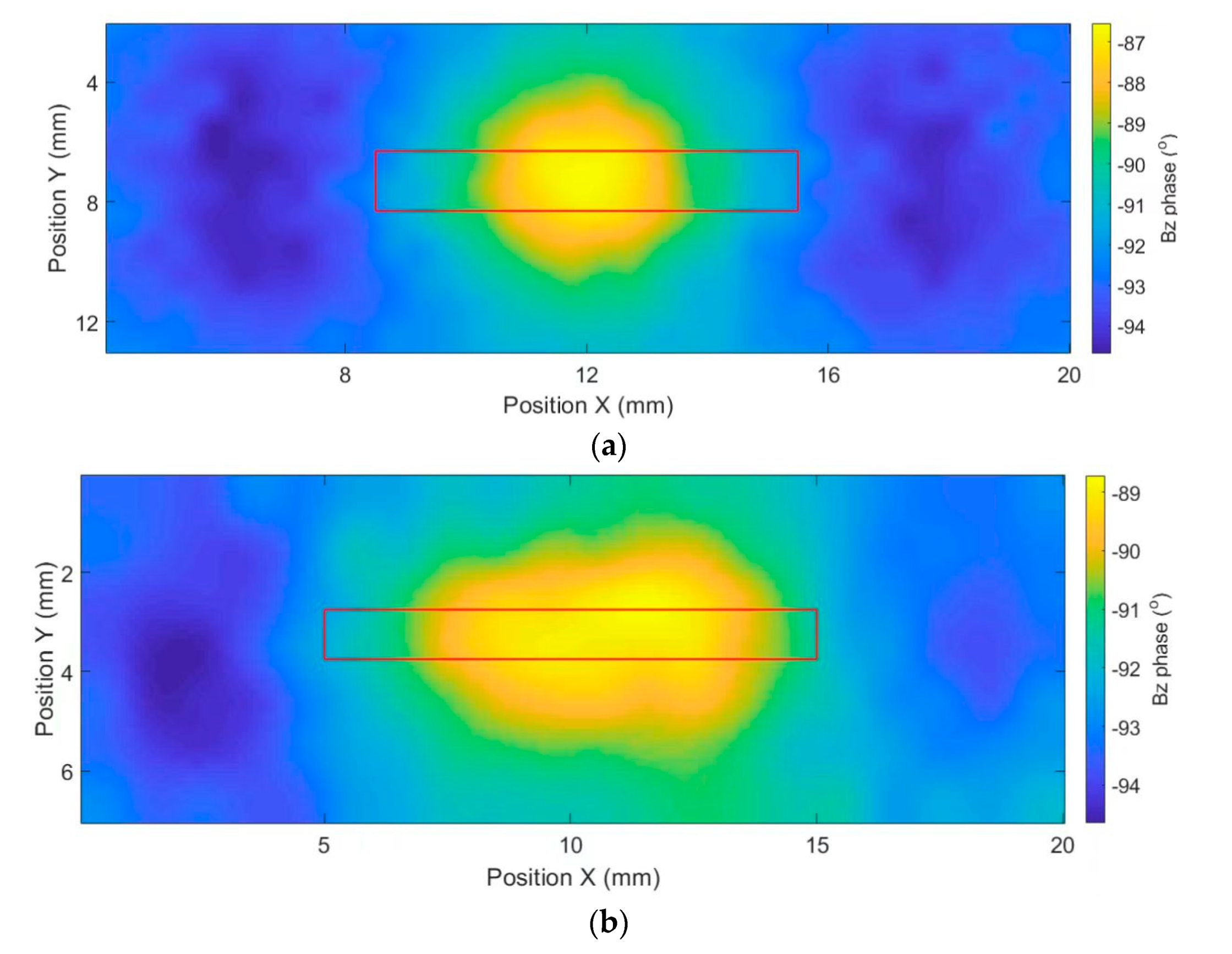Improving Magnetic Field Response of Eddy Current Magneto-Optical Imaging for Defect Detection in Carbon Fiber Reinforced Polymers
Abstract
:1. Introduction
2. Eddy Current Magneto-Optical Imaging System Settings
2.1. The Principle of Magneto-Optical Imaging Based on the Faraday Effect
2.2. Eddy Current Magneto-Optical Defect Detection System
3. Eddy Current Magneto-Optical Imaging Theoretical Analysis and Simulation of Carbon Fiber Reinforced Polymer Cracks
3.1. Carbon Fiber Reinforced Polymer Electromagnetic Model
3.2. Detection of Crack Defects
4. Experimental Verification of Eddy Current Magneto-Optical Phase Imaging of CFRP Crack Defects
4.1. Line Scan Detection
4.2. Line Scan Detection
5. Conclusions
Author Contributions
Funding
Data Availability Statement
Conflicts of Interest
References
- Zheng, H.; Zhang, W.; Li, B.; Zhu, J.; Wang, C.; Song, G.; Wu, G.; Yang, X.; Huang, Y.; Ma, L. Recent advances of interphases in carbon fiber-reinforced polymer composites: A review. Compos. Part B Eng. 2022, 233, 109639. [Google Scholar] [CrossRef]
- Danish, A.; Mosaberpanah, M.A.; Salim, M.U.; Amran, M.; Fediuk, R.; Ozbakkaloglu, T.; Rashid, M.F. Utilization of recycled carbon fiber reinforced polymer in cementitious composites: A critical review. J. Build. Eng. 2022, 53, 104583. [Google Scholar] [CrossRef]
- Gangineni, P.K.; Ganesh Gupta, B.N.V.S.K.; Patnaik, S.; Prusty, R.K.; Ray, B.C. Recent advancements in interface engineering of carbon fiber reinforced polymer composites and their durability studies at different service temperatures. Polym. Compos. 2022, 43, 4126–4164. [Google Scholar] [CrossRef]
- Gupta, S.; Sharma, A.; Varma, R.K.; Kushvaha, V. A review on performance of near-surface mounted-carbon fiber-reinforced polymer laminates bonded into slits. Polym. Compos. 2022, 43, 6782–6802. [Google Scholar] [CrossRef]
- Wu, Y.; Wang, K.; Neto, V.; Peng, Y.; Valente, R.; Ahzi, S. Interfacial behaviors of continuous carbon fiber reinforced polymers manufactured by fused filament fabrication: A review and prospect. Int. J. Mater. Form. 2022, 15, 18. [Google Scholar] [CrossRef]
- Song, Y.; Cao, H.; Zheng, W.; Qu, D.; Liu, L.; Yan, C. Cutting force modeling of machining carbon fiber reinforced polymer (CFRP) composites: A review. Compos. Struct. 2022, 299, 116096. [Google Scholar] [CrossRef]
- Cho, S.Y. Investigation of manufacturing defects in 3D-printed CFRP using laser ultrasonic testing and x-ray micro-computed tomography. Funct. Compos. Struct. 2021, 3, 025005. [Google Scholar] [CrossRef]
- Zhu, P.P.; Bai, L.B.; Cheng, Y.H. Feature Extraction Approach for Defect Inspection in Eddy Current Pulsed Thermography. J. Electron. Sci. Technol. 2021, 19, 11. [Google Scholar]
- Iqbal, S.; Bahadur, A.; Ali, S.; Ahmad, Z.; Javed, M.; Irfan, R.M.; Ahmad, N.; Qamar, M.A.; Liu, G.; Akbar, M.B.; et al. Critical role of the heterojunction interface of silver decorated ZnO nanocomposite with sulfurized graphitic carbon nitride heterostructure materials for photocatalytic applications. J. Alloys Compd. 2021, 858, 158338. [Google Scholar] [CrossRef]
- Zhu, J.; Wu, C.; Cui, Y.; Li, D.; Zhang, Y.; Xu, J.; Li, C.; Iqbal, S.; Cao, M. Blue-emitting carbon quantum dots: Ultrafast microwave synthesis, purification and strong fluorescence in organic solvents. Colloids Surf. A Physicochem. Eng. Asp. 2021, 623, 126673. [Google Scholar] [CrossRef]
- Huang, L.; Li, J.; Li, B. Experimental research on ultrasonic A-scan testing technology of composite solid propellant. J. Phys. Conf. Ser. 2022, 2338, 012011. [Google Scholar] [CrossRef]
- Qin, Z.Z.; Barrett, R.; Del Mar Castro, M.; Zaidi, S.; Codlin, A.; Creswell, J.; Denkinger, C. Early user experience and lessons learned using ultra-portable digital X-ray with computer-aided detection (DXR-CAD) products: A qualitative study from the perspective of healthcare providers. PLoS ONE 2023, 18, e0277843. [Google Scholar] [CrossRef]
- Panahandeh, S.; May, D.; Grosse-Kockert, C.; Schacht, R.; Ras, M.A.; Wunderle, B. Pulsed infrared thermal imaging as inline quality assessment tool. Microelectron. Reliab. 2023, 142, 114910. [Google Scholar] [CrossRef]
- Gudino, N.; Littin, S. Advancements in Gradient System Performance for Clinical and Research MRI. J. Magn. Reson. Imaging 2023, 57, 57–70. [Google Scholar] [CrossRef]
- An, J.H.; Ahmed, H.; Lee, J.R. Defect visualization of cylindrical and conical CFRP lattice structures using rotational ultrasonic propagation imager. Meas. Sci. Technol. 2021, 32, 124001. [Google Scholar] [CrossRef]
- Hendroprasetyo, W.; Andrian, H. Analysis of Eddy Current Testing Detection Ability to the Varied Longitudinal Cracks on Coated Weld Metal Tee Joint of 5083 Aluminum Ship Structure. IOP Conf. Ser. Earth Environ. Sci. 2022, 972, 012041. [Google Scholar] [CrossRef]
- Schulze, M.H.; Heuer, H.; Kuettner, M. High-resolution eddy current sensor system. In Proceedings of the Conference on Smart Sensors, Actuators, and MEMS IV, Dresden, Germany, 18 May 2009. [Google Scholar]
- Heuer, H.; Schulze, M.H.; Meyendorf, N. Non-destructive evaluation (NDE) of composites: Eddy current techniques. Non-Destr. Eval. (NDE) Polym. Matrix Compos. 2013, 3, 33–55. [Google Scholar]
- Cheng, J.; Qiu, J.; Ji, H.; Wang, E.; Takagi, T.; Uchimoto, T. Application of low frequency ECT method in noncontact detection and visualization of CFRP material. Compos. Part B Eng. 2017, 110, 141–152. [Google Scholar] [CrossRef]
- Zhang, N.; Ye, C.; Peng, L.; Tao, Y. Eddy current probe with three-phase excitation and integrated array tunnel magnetoresistance sensors. IEEE Trans. Ind. Electron. 2020, 68, 5325–5336. [Google Scholar] [CrossRef]
- Joubert, P.Y.; Pinassaud, J. Linear magneto-optic imager for non-destructive evaluation. Sens. Actuators A Phys. 2006, 129, 126–130. [Google Scholar] [CrossRef]
- Cheng, Y.; Deng, Y.; Bai, L.; Chen, K. Enhanced laser-based magneto-optic imaging system for nondestructive evaluation applications. IEEE Trans. Instrum. Meas. 2012, 62, 1192–1198. [Google Scholar] [CrossRef]
- Hafez, J.M.; Gao, J.; Eden, J.G. Detection of weak (0.5–300 nT), low frequency (5–100 Hz) magnetic fields at room temperature by kilohertz modulation of the magneto-optical hysteresis in rare earth–iron garnet films. Appl. Phys. Lett. 2007, 90, 132502. [Google Scholar] [CrossRef]
- Vishnevskii, V.; Berzhansky, V.N.; Mikhailov, V.; Pankov, F.; Nesteruk, A. Magneto-Optic Eddy Current Introscopy Based on Garnet Films. In Proceedings of the IEEE International Conference on Oxide Materials for Electronic Engineering, Lviv, Ukraine, 3–7 September 2012. [Google Scholar]
- Deeter, M.N.; Rose, A.H.; Day, G.W. Fast, sensitive magnetic-field sensors based on the Faraday effect in YIG. J. Light. Technol. 2002, 8, 1838–1842. [Google Scholar] [CrossRef] [Green Version]
- Amirsolaimani, B.; Gangopadhyay, P.; Persoons, A.; Showghi, S.; LaComb, L.; Norwood, R.; Peyghambarian, N. High sensitivity magnetometer using nanocomposite polymers with large magneto-optic response: Retraction. Opt. Lett. 2020, 20, 45. [Google Scholar] [CrossRef]
- Gao, X.; Zhou, X.; Wang, C.; Ma, N.; You, D. Skin depth and detection ability of magneto-optical imaging for weld defects in alternating magnetic field. J. Manuf. Syst. 2020, 55, 44–55. [Google Scholar] [CrossRef]
- Berzhansky, V.N.; Filippov, D.M.; Lugovskoy, N.V. Magneto-optical visualization of eddy current magnetic fields. Phys. Procedia 2016, 82, 27–31. [Google Scholar] [CrossRef] [Green Version]
- Xue, Y.; Qing-Hui, Y.; Huai-Wu, Z.; Qi-Ye, W.; Fei-Ming, B.; Zhi-Yong, Z.; Ding, Z.; Jian-Tao, H. Preparation and orientation mechanism analysis of (BiTm)3(GaFe)5O12 magneto-optical single crystal film with out-of-plane orientation. Acta Phys. Sin. 2021, 70, 1078011. [Google Scholar]
- Qin, J.; Xia, S.; Jia, K.; Wang, C.; Tang, T.; Lu, H.; Zhang, L.; Zhou, P.; Peng, B.; Deng, L.; et al. Enhancement of the Faraday effect and magneto-optical figure of merit in all-dielectric metasurfaces. ACS Photonics 2022, 9, 1240–1247. [Google Scholar]
- Karakhanyan, V.; Eustache, C.; Lefier, Y.; Grosjean, T. Inverse Faraday effect from the orbital angular momentum of light. Phys. Rev. B 2022, 105, 045406. [Google Scholar] [CrossRef]
- Mao, X.; Qin, G.-Q.; Yang, H.; Wang, Z.; Wang, M.; Li, G.-Q.; Xue, P.; Long, G.-L. Tunable partial polarization beam splitter and optomechanically induced Faraday effect. Phys. Rev. A 2022, 105, 033526. [Google Scholar] [CrossRef]
- Radtke, U.; Zielke, R.; Rademacher, H.G.; Crostack, H.A.; Hergt, R. Application of magneto-optical method for real-time visualization of eddy currents with high spatial resolution for nondestructive testing. Opt. Lasers Eng. 2001, 36, 251–268. [Google Scholar] [CrossRef]









Disclaimer/Publisher’s Note: The statements, opinions and data contained in all publications are solely those of the individual author(s) and contributor(s) and not of MDPI and/or the editor(s). MDPI and/or the editor(s) disclaim responsibility for any injury to people or property resulting from any ideas, methods, instructions or products referred to in the content. |
© 2023 by the authors. Licensee MDPI, Basel, Switzerland. This article is an open access article distributed under the terms and conditions of the Creative Commons Attribution (CC BY) license (https://creativecommons.org/licenses/by/4.0/).
Share and Cite
Ai, J.; Zhou, Q.; Zhang, X.; Li, S.; Long, B.; Bai, L. Improving Magnetic Field Response of Eddy Current Magneto-Optical Imaging for Defect Detection in Carbon Fiber Reinforced Polymers. Appl. Sci. 2023, 13, 4541. https://doi.org/10.3390/app13074541
Ai J, Zhou Q, Zhang X, Li S, Long B, Bai L. Improving Magnetic Field Response of Eddy Current Magneto-Optical Imaging for Defect Detection in Carbon Fiber Reinforced Polymers. Applied Sciences. 2023; 13(7):4541. https://doi.org/10.3390/app13074541
Chicago/Turabian StyleAi, Jiangshan, Quan Zhou, Xu Zhang, Shengping Li, Bing Long, and Libing Bai. 2023. "Improving Magnetic Field Response of Eddy Current Magneto-Optical Imaging for Defect Detection in Carbon Fiber Reinforced Polymers" Applied Sciences 13, no. 7: 4541. https://doi.org/10.3390/app13074541




